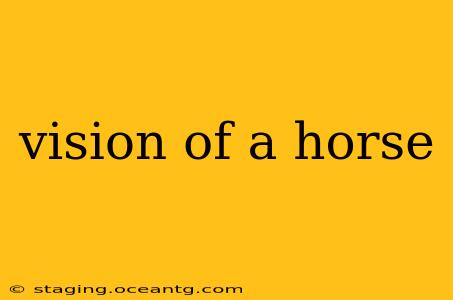The vision of a horse—a powerful, graceful creature—evokes a range of emotions and interpretations. From the majestic wild mustang to the elegantly trained show jumper, the horse holds a unique place in human history and imagination. This captivating animal has inspired art, literature, mythology, and even our language, imbuing it with symbolic meanings that vary across cultures. This article delves into the diverse visions of a horse, exploring its beauty, power, symbolism, and the enduring fascination it holds for humankind.
What Makes a Horse's Vision Unique?
Horses, like humans, have binocular and monocular vision. However, their visual system is adapted to their needs as prey animals. Their eyes are positioned on the sides of their heads, providing a wide field of vision—almost 360 degrees—allowing them to detect predators approaching from almost any direction. This panoramic view comes at the cost of a smaller area of binocular vision, meaning their depth perception is less precise than ours, especially at close range. They compensate for this by using other sensory inputs, such as hearing and smell, to navigate their surroundings effectively.
What is the Symbolic Meaning of a Horse?
The symbolism associated with horses is rich and varied, often reflecting their qualities. In many cultures, horses represent:
- Freedom and Wildness: The untamed spirit of the wild horse embodies freedom and untamed power, often associated with untamed nature and independence.
- Power and Strength: Horses have long been associated with strength, both physical and spiritual. Their capacity for work and their impressive physique contribute to this powerful image.
- Grace and Beauty: The elegance of a horse's movement, the lustrous shine of its coat, and the overall harmony of its form contribute to its widely appreciated beauty.
- Loyalty and Companionship: The bond between horse and rider is a testament to the loyalty and companionship that can be shared between humans and animals.
- Nobility and Status: Throughout history, horses have been symbols of nobility and high social standing, often associated with royalty and military leaders.
What are Different Breeds of Horses and How Do Their Appearances Vary?
The sheer variety of horse breeds is astonishing, each with its unique characteristics and appearance. We see differences in size, build, coat color, and even temperament. Some examples include:
- Arabian horses: Known for their refined features, stamina, and elegant appearance.
- Thoroughbreds: Celebrated for their speed and athleticism, often used in racing.
- Clydesdales: Impressive draft horses, recognizable by their size, feathered legs, and gentle nature.
- Shetland ponies: Small, sturdy ponies, often favored for their gentle temperament and suitability for children.
- Mustangs: Wild horses of the American West, embodying freedom and resilience.
How Does a Horse's Vision Affect its Behavior?
A horse's wide field of vision is crucial for its survival in the wild. It allows them to quickly detect potential threats and react accordingly. Their ability to perceive movement from a distance is particularly important. This contributes to their characteristically alert and responsive behavior. Understanding their visual limitations, particularly in depth perception at close range, is crucial for safe and effective interaction with horses.
Conclusion: A Multifaceted Vision
The vision of a horse—both literally and figuratively—is complex and multifaceted. Their remarkable visual capabilities, combined with their power, beauty, and cultural significance, have resulted in an enduring fascination that continues to shape art, literature, and our understanding of the natural world. From the untamed spirit of the wild mustang to the loyal companionship of a domestic horse, the vision of a horse continues to inspire awe and wonder.
